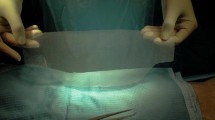Abstract
Background:
The endoscopic preperitoneal approach has numerous advantages for the reconstruction of bilateral inguinal hernias. Repair may be achieved using either one large or two small meshes. The aim of this study was to investigate whether one of the techniques was superior in terms of recurrence and complication rate.
Methods:
Data obtained from 113 patients who underwent surgery between January 1998 and December 2001 was reviewed. For the sake of this study, 86% of all patients were examined for hernia recurrence at an additional outpatient visit.
Results:
The findings showed recurrence rates, of 3.5% for single mesh and 3.7% for double mesh. This difference was not significant. Complication rates did not differ significantly between the groups.
Conclusions:
Endoscopic preperitoneal bilateral hernia repair is a safe and reliable technique in the hands of experienced surgeons. The rate of hernia recurrence and complications is low and independent of the mesh configuration (single or double). Mesh configuration based on personal preference is permissible.

Similar content being viewed by others
References
(2003) Richtlijn Behandeling van de liesbreuk. Alphen aan den Rijn, van Zuiden Communications B.V
Baeten CG, van Geldere D, Kootstra G (1990) Current treatment of bilateral recurrent inguinal hernias using preperitoneal Marlex mesh prosthesis. Ned Tijdschr Geneeskd 134: 535––537
Berndsen F, Petersson U, Montgomery A (2001) Endoscopic repair of bilateral inguinal hernias: short and late outcome. Hernia 5: 192–195
Champault GG, Rizk N, Catheline JM, Turner R, Boutelier P (1997) Inguinal hernia repair: totally preperitoneal laparoscopic approach versus Stoppa operation: randomized trial of 100 cases. Surg Laparosc Endosc 7: 445–450
Frankum CE, Ramshaw BJ, White J, Duncan TD, Wilson RA, Mason EM, Lucas G , Promes J (1999) Laparoscopic repair of bilateral and recurrent hernias. Am Surg 65: 839–843
Geis WP, Malago M (1994) Laparoscopic bilateral inguinal herniorrhaphies: use of a single giant preperitoneal mesh patch. Am Surg 60: 558–563
Kald A, Domeij E, Landin S, Wiren M, Anderberg B (2000) Laparoscopic hernia repair in patients with bilateral groin hernias. Eur J Surg 166: 210–212
Knook MT, Weidema WF, Stassen LP, Boelhouwer RU, van Steensel CJ (1999) Endoscopic totally extraperitoneal repair of bilateral inguinal hernias. Br J Surg 86: 1312–1316
Liem MS, van der Graaf Y, van Steensel CJ, Boelhouwer RU, Clevers GJ, Meijer WS, Stassen LP, Vente JP, Weidema WF, Schrijvers AJ, van Vroonhoven TJ (1997) Comparison of conventional anterior surgery and laparoscopic surgery for inguinal-hernia repair. N Engl J Med 336: 1541–1547
Liem MSL, van Steensel CJ, Boelhouwer RU, et al. (1996) The learning curve for totally extraperitoneal laparoscopic inguinal hernia repair. Am J Surg 171: 281–285
Miller AR, van Heerden JA, Naessens JM, O’Brien PC (1991) Simultaneous bilateral hernia repair: a case against conventional wisdom. Ann Surg 213: 272–276
Neumayer L, Giobbie-Hurder A, Jonasson O, Fitzgibbons R, Jr., Dunlop D, Gibbs J, Reda D, Henderson W (2004) Open mesh versus laparoscopic mesh repair of inguinal hernia. N Engl J Med 350: 1819–1827
Nyhus LM (1993) Individualization of hernia repair: a new era. Surgery 114: 1–2
Serpell JW, Johnson CD, Jarrett PE (1990) A prospective study of bilateral inguinal hernia repair. Ann R Coll Surg Engl 72: 299–303
Simons MP, de Lange D, Beets GL, van Geldere D, Heij HA, Go PM (2003) The “Inguinal Hernia” guideline of the Association of Surgeons of the Netherlands. Ned Tijdschr Geneeskd 147: 2111–2117
Stoppa RE (2003) Wrapping the visceral sac into a bilateral mesh prosthesis in groin hernia repair. Hernia 7: 2–12
Stott MA, Sutton R, Royle GT (1988) Bilateral inguinal hernias: simultaneous or sequential repair? Postgrad Med J 64: 375–378
Velasco JM, Gelman C, Vallina VL (1996) Preperitoneal bilateral inguinal herniorrhaphy evolution of a technique from conventional to laparoscopic. Surg Endosc 10: 122–127
Author information
Authors and Affiliations
Corresponding author
Rights and permissions
About this article
Cite this article
Halm, J.A., Heisterkamp, J., Boelhouwer, R.U. et al. Totally extraperitoneal repair for bilateral inguinal hernia: Does mesh configuration matter?. Surg Endosc 19, 1373–1376 (2005). https://doi.org/10.1007/s00464-004-2268-2
Received:
Accepted:
Published:
Issue Date:
DOI: https://doi.org/10.1007/s00464-004-2268-2




